

Pages in this Folder:

Related Folders:
See also Department Site Map
Support Provided by

Toronto Parks and Trees Foundation
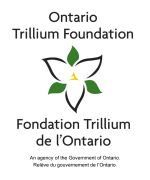
This website has received support from celos.ca through the Trillium foundation.
Publications
Comments?
For the basics, see
- Website & Privacy Policies
- How To Get Involved
- The Role of the Park
Search options:
Department Site Map
Custodians:
 News 2006
News 2006
Quick Page Table of Contents
Scanning...
News, 2006
posted April 8, 2006
A different template for neighborhood public space
Dufferin Grove Park is a laboratory for a different approach to staffing neighbourhood public space than is the norm in Toronto. The norm is that the City hires mainly young people, often under 20, as recreation “casual staff” for neighborhood community centres and parks. Most of them are paid minimum wage or a few dollars more, and slotted into narrowly defined tasks without much direct guidance. There’s a pretty big chasm between them and the managers developing policies and procedures in meetings downtown.
But Dufferin Grove Park tries to provide chances for staff with a greater range of ages and gifts to try new things. Although the pay is still well below that of the park maintenance workers who cut the grass, it’s a bit closer to what a single person can live on (cheap). Supervision and collegial help are strong. What’s more, the boundary between park staff and park friends is very permeable, so that almost all park projects involve both.
Besides keeping the park in good order, a big part of this staff’s task is to remove the barriers that stop people from trying new things in public space (like building a cob courtyard or setting up a neighborhood pick-up soccer game). At the same time, the staff have to keep a close eye and friendly hand on projects as they develop.
The other big part of their task is to address public conflict with energy and intelligence. Parks can be places of friendship, surprising beauty, and excitement, but they can also become a stage for ugly intimidation. Park staff have to subvert people who enjoy making trouble. Setting safety policies in meetings at City Hall doesn’t help the park without experienced on-site staff paying good attention, maybe in the rink house, or in the playground, or while picking litter, or making coffee at the food cart. Trouble is addressed by park staff who are in the park day after day, until their knowledge of the park and the people there becomes very solid, and follow-up is fast and sustained.
If this Dufferin Grove "template" finds no application in Toronto’s public space (including other parks) parks will become poorer, sadder places and decreasingly useful to their neighborhoods. That’s why park friends are pretty steadfast in their resistance to dismantling what’s developed at this park.
At this point, the funds raised at Dufferin Grove Park are handled by CELOS:
CELOS is in discussion with City staff to work out a more direct way of cash-handling, since the experiment of raising park funds through food is part of CELOS' mandate, but the continuation (and replication of this kind of fund-raising at other locations) is up to the City.
From the August 2006 Newsletter:
posted August 2, 2006
PARKING PROBLEM BY THE PLAYGROUND
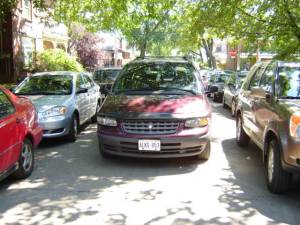
Parked cars at the bottom of the park,
blocking residents' laneway access
The little dead-end bit of Gladstone Avenue right by the playground has legal parking spaces for only four cars on the east side of the street. The west side of the street has two “no stopping” signs, but they are not obvious.
That little street is the only access to the laneway behind the houses on that stretch of Lindsay Avenue, where residents park their cars. In this hot summer, when so many people come to the playground wading pool, there are usually between 5 and 10 cars parked on the dead-end street illegally. That makes the street so congested that residents are often blocked from getting their cars out of the laneway.
A friend of the park is painting a big “no parking” sign. Park users can help too – if you see someone parking there, point out the signs to them. Otherwise they might get a very expensive ticket, which would spoil their day at the park.
|
No parking signs painted by park staff | |
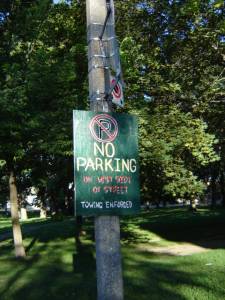 |
 |
posted April 8, 2006
Where your cookie money went:
During the winter, a lot of the snack bar and park bread money went to buy more food supplies, of course, but what was left over went into paying for extra youth workers, web site maintenance, and some special projects. For example: $250 went to rent a bus so the Jimmie Simpson Rink "Hockey in the Neighbourhood" program could bring all their kids over for a shinny hockey tournament. $40 went to rent sound equipment from Long and McQuade, so that park staff (and DJ) Ted Carlisle could spin his disks at the first-ever rink DJ night on the last Friday in February. (That was so much fun that Ted and park staff/ dancer Eroca Nicols are planning a few summertime DJ and line-dancing evenings in the park for the summer.) $300 went to MacGregor Park to help them buy paints and ink for Kristen Fahrig’s Tibetan-flag-making project this spring. More details are posted on the "about us" page of the park web site.
posted April 8, 2006
Snack bar food prices for the playground:
When the water gets turned on again at the outdoor kitchen and the food cart returns to the playground, the same pricing rules apply as in the wintertime at the rink’s zamboni snack bar. The price list reflects how much money is needed to pay for the materials that went into the food, plus a bit extra for other park uses. But if your grocery money is tight, and you and your kids are hungry because of all that fresh air, even the cheap snack bar food prices may add up too fast. If you’re hungry, but you can’t pay as much for the snack bar food, pay less. Park staff also like to do trades – if you can do something for the park (help pick up litter at the playground, water the gardens, wash dishes, sort tools in the tool cupboard, break up wooden skids for the bread ovens) the park staff will tell you your money won’t work at the snack bar, and you eat for free. That goes for kids too. On the other hand, if you find the food very cheap and good, and think it should cost more, go ahead and pay more. Every penny goes to the park.
But nobody has to pay a set amount for the food, nor does anyone have to show proof that they can’t pay. The snack bar money is a collective gift to the park from park users, a pooling of resources that can then be used to make the park even nicer. For details on how that pool of money has been used, go to the park web site (www.dufferinpark.ca) and click on “about us.” To give more suggestions for good ways to use the food money, talk to any of the park staff. Good ideas are also gifts that shape the park.
posted April 8, 2006
The park staffing budget and cost recovery by the City of Toronto:
For some years now, friends of the park have been asking the City’s Parks and Recreation Division to recognize Dufferin Grove Park as a kind of neighborhood laboratory of public space, a community centre without walls. Noting that most of the City’s community centres with walls cost upwards of $600,000 a year to run, and that this park has become at least as busy, we asked for a staffing budget of $164,000, for Dufferin Grove. This request was never taken seriously. But in 2005, the local recreation supervisor, Tino DeCastro, was willing to try an experiment. He had enough money from user fees (from programs at Mary McCormick Community Centre and Wallace-Emerson Community Centre), that he could assign almost as much as we asked, for staff working at Dufferin Grove Park. (His total area budget was about $1.6 million, and user fees for those centres brought in another $1.1 million – in this area there are the two community centres, and Dufferin Grove is the main park).
Dufferin Grove Park worked much better as a result of the improved staffing. But the Parks and Recreation management was not pleased, and in February Recreation Director Don Boyle said the park would have to return to a recreation budget of only $65,600 a year.
posted April 8, 2006
What do our taxes pay for?
Numerous difficult discussions with management since then have circled around the idea of "cost recovery." Dufferin Grove Park is a problem, because it does not charge user fees for most of what goes on there. The costs of paying staff – to make the park work well – are thus un-recovered, and counted as a loss.
This is a puzzle. After all, people do pay taxes to run the parks. $141 million of our taxes will go to the Parks and Recreation Division to look after public space in 2006. User fees bring in many millions more.
If the goal is total "cost recovery" for parks and recreation staffing costs, what are the $141 million in taxes for?
posted April 8, 2006
Multiplying managers:
One big cost is the ever-increasing bulk of management. Besides the general manager (called a "commissioner" in many cities), Parks and Recreation now has six directors and 36 managers, who in turn have many supervisors working under them. Five of the managers are "managers of management services." There’s a director of "divisional coordination and compliance" and under her there is a "manager of agenda coordination and service integration." The jobs of some of these managers are so broad it’s hard to know how they could ever become practical. For instance, the “manager of community development” says her job is "rolling out a community engagement plan for the entire division...to create Parks, Forestry and Recreation Teams in geographical regions... These teams will ensure all staff ... are engaging and rolling out community development initiatives i.e. volunteer management plan, advisory councils, crisis management, special events..."
The people who are assigned to manage public space in this way cost quite a lot. The salaries of two managers are the same as the total City wages of all the recreation staff who run Dufferin Grove Park year-round.
New managers are still being added, not always billed as such. For instance, Parks and Recreation just hired 19 new staff whose job is explicitly not direct service but rather to track down "youth with a disability, newcomer youth, youth from at-risk neighborhoods, aboriginal youth, and youth from racially diverse, culturally diverse, sexually diverse, and gender diverse communities," to go to meetings about such youth and to monitor/educate Parks and Recreation staff in how they deal with them, to do liaison with other agencies about them, and to write a large number of administrative reports. The jobs are permanent, the wages are good, and insiders at City Hall warned right away that this group was simply a new layer of management. Direct recreation programs for youth remain understaffed.
posted April 8, 2006
PARK SUPPORT FROM CITY COUNCILLOR ADAM GIAMBRONE
When Councillor Giambrone heard that Parks and Recreation management wanted to cut back park staffing, he promised to protect what has been built up there. He asked for a list of what the staff do when working in the park. After the staff and some park friends went through the park log books (and the archived newsletters on the park web site), the Councillor got a list that ran to eight pages.
Jutta Mason bound it into a booklet, along with some relevant newsletter excerpts, numbers, and front and back cover picture-collages of the park. The booklet is available at the rink house for anyone interested, and it will be useful for people visiting from elsewhere, curious to find out how a neighborhood park such as Dufferin Grove works. There is certainly an interest – from Germany, Britain, South Africa, the U.S., other parts of Canada, and six other neighborhoods across town (in the past year). (lots!),
In early March the park’s research group (CELOS) applied to the Ontario Trillium Foundation for a small grant to put on a conference at the park in September, to be called "Cheap Parks/ community centres without walls." It’s meant to be an occasion when interested people in Toronto can swap experiences and come up with some good, practical, ready-to-do solutions to their own park problems.
Park friends who approve of Councillor Giambrone’s support for Dufferin Grove might want to let him know – it’s always nice to find out people like what you’re doing – his phone number at City Hall is 416 392-7012.
posted February 10, 2006
Where the "cookie money" went in 2005:
This is the money that park users gave for park food, and that was then in turn used to fund the following things outside of the city budget:
- Materials and supplies: $19,972 (This ranges from first aid supplies, paint and game pieces, to appliance repair and kitchen cupboards and fridge for the zamboni kitchen renovations. It also includes some items that are re-sold, such as swim diapers and hockey pucks.)
- contracts for extra workers to try new things in the park: $22,526.06
- contracts for researching broader park and public space issues: $14,508.55
- park web site management: $10,946.49
- groceries: $57,567.30
- building the cob courtyard: $4,984.50
posted April 8, 2006
Heroes of the Park
Tere Oulette, the owner of a wonderful toy store called Scooter Girl Toys at 187 Roncesvalles, and a very loyal friend of the park, sent us postdated cheques to sponsor 100 newsletters per month ($46) for the whole of 2006. That’s being a park friend for the long haul!
Suchada Promsiri, who brought in $100 from her tip jar at her Osogood sandwich and pastry shop ("pastry from scratch"), on College Street a block east of the Dovercourt Y. Suchada has been spoiling the park staff for years with her care-packages of delicious snacks "to keep their spirits up," and this newsletter is not the first one she funded so generously.
Edward Cayley, a retired schoolmaster, who liked the April newsletter so well he pledged $100 a month for the rest of 2006 -- to print more newsletters after the first 200 run out (which is often before the middle of the month).
posted April 8, 2006
Counterfeit twenties
In the last six weeks of the rink season, the rink snack bar took in almost $200 of counterfeit twenties. It took a long time to notice that this was a pattern and not just bad luck. The farmers at the market didn’t get any bad bills, and the CIBC bank manager at Dufferin and Bloor said they hadn’t noticed an unusual number of bad twenties there. That led to the conclusion that one or several of the Dufferin Rink rats have diversified into a new line of business, and that the rink snack bar was an easy mark, because no one examined the money until after it got deposited in the bank account.
But now the Bank of Canada is sending the park a lot of coloured pictures of bank note security features. The rink season is over, but the bakers and everyone else will be looking for fakes during the market and when the playground outdoor snack bar starts up. (It’s actually pretty easy, once you’re suspicious.) It’s our hunch that there won’t be counterfeit twenties again until next winter. With a little help from the RCMP, maybe never.


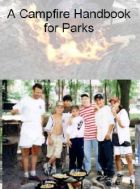
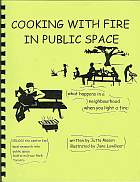


 Printer friendly version
Printer friendly version